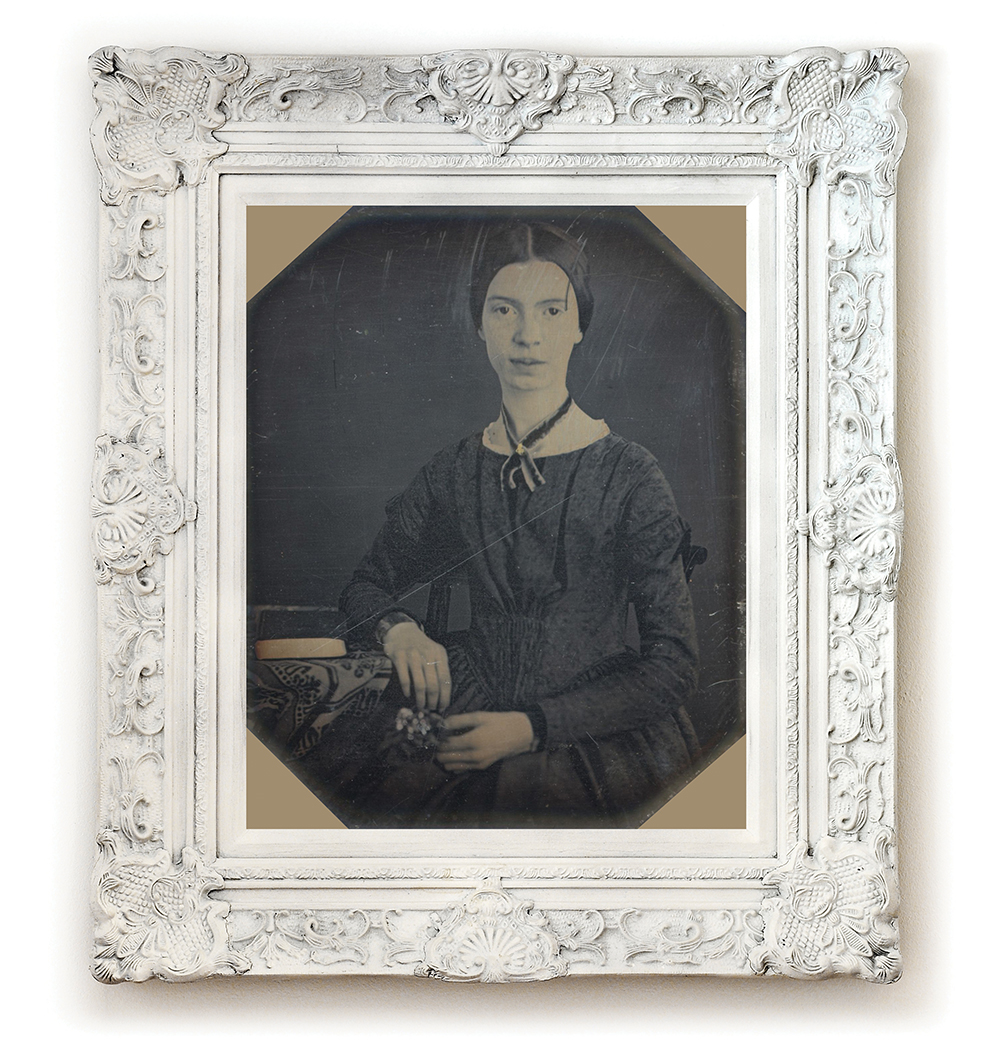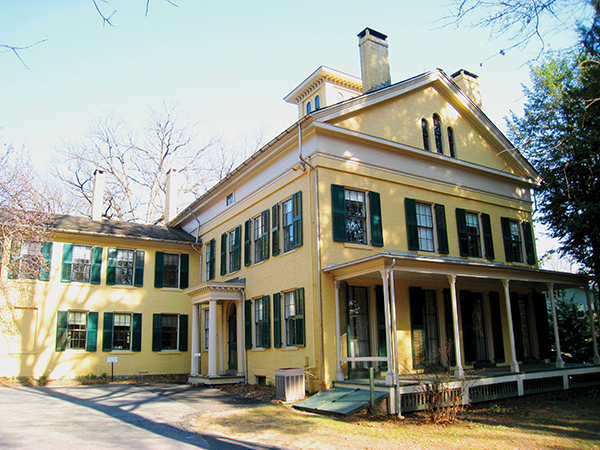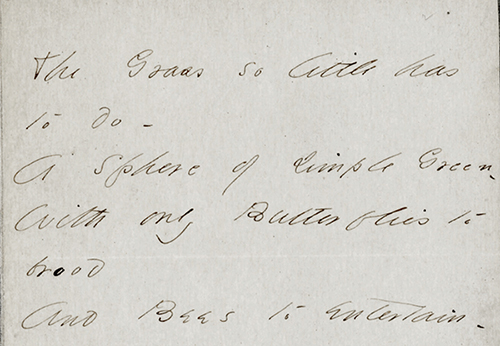 A Solitude of Space
A Solitude of Space
By Eric D. Lehman and Amy Nawrocki
Three miles from the Connecticut River, we stood in a circle under a tree in the garden of Emily Dickinson’s home, reading poems, passing a book around, no more than two or three feet from each other. The 1813 Amherst home built for her grandparents stood proudly in the sunshine, and the voices of another tour group filtered out. We had just been guided through the house and visited her modest bedroom with its tiny writing desk by the window, a place to watch the world go by. We shook hands in greeting, jostled each other on the stairway, and talked freely in small rooms without the benefit of masks.
That all seems a long time ago. As I write this today, the house remains shuttered, tours are forbidden, and potential visitors are peering out from our own windows at the world. In that way we are closer to Emily Dickinson, and to her solitary way of living, than we ever have been. What lessons might this genius of American letters have for us during this time of rolling quarantine and periodic isolation?

A daguerreotype of Emily Dickinson, circa early 1847 taken by an unknown photographer. It is presently located in Amherst College Archives & Special Collections.
Images credit: CC-PD Wikimedia Commons; Getty Images, Anagramm (picture frame).
Born in 1830, well-educated early in life, Dickinson relied on foundational knowledge in literature, botany, history, and a love of learning which cultivated her imagination, especially after her formal schooling ended as a teen. She attended Mount Holyoke Female Seminary for a short time, before illnesses and deaths of those close to her meant she would “homeschool” for the rest of her life. It was the beginning of a longer and more profound self-isolation.
Isolation has been a watchword in New England for centuries, going back at least to William Blackstone, who lived alone in a hut on what is today Beacon Hill, and then fled to the wilds of Rhode Island to escape the growing population of Boston. But there are differences between the classic Yankee hermits and Dickinson. She didn’t necessarily hate people or the social interactions of a busy life. Something else took her into her room, and people still argue today what that was, with each generation taking a new theory to heart.
One of those theories is uncomfortably familiar. During her lifetime, the world dealt with another plague, one that ravaged the lungs of many 19th century poets, such as John Keats and Elizabeth Barrett Browning, as well as less artistic folks. Dickinson experienced bouts of coughing and illness between 1846 and 1852 that were treated with glycerin by Boston specialists as symptoms of “consumption”—the slow-moving but deadly tuberculosis. Her father, Edward, feared that she would catch it from childhood onward, and some point to this founding fear as one of the roots of her self-isolation. For at least two decades, she stayed indoors, talked to people through doors and windows, and spent time with few outside her family circle, just as we are doing today.
However, when she writes about solitude, she does not seem to be fearful. Here she is in a selection taken from her Collected Poems (Little Brown, 1924):
There is a solitude of space,
A solitude of sea,
A solitude of death, but these
Society shall be,
Compared with that profounder site,
That polar privacy,
A Soul admitted to Itself:
Finite Infinity.
She seemed to enjoy her chosen solitude, writing to T.W. Higginson that she “never thought of conceiving” that she wanted a “social” life. She had the people closest to her, her garden, and her private art. And she could still interact with the world: she sent thousands of letters to friends like Higginson. Her ability to focus and put experience into words intensified through the lens of a particular correspondent. After all, as she writes: “Distance is not the realm of Fox,/Nor by relay as Bird;/Abated, Distance is until/Thyself, Beloved!”

An example of Emily Dickinson's handwriting.
Images credit: Manuscript Division, Library of Congress, Washington, DC
The tour guides at the Dickinson home like to tell the story of how during a visit from her niece Mattie, Emily took the young girl into the bedroom and locked it with an invisible key, saying, “It’s just a turn, and freedom.” Being isolated forces us to think about freedom in new ways and consider meanings beyond the merely political. She writes: “Captivity is consciousness,/So’s liberty.” Freedom is in our minds, in our imaginations.
In some ways, this makes her the “anti-quarantine” poet, with poems that celebrate the outdoors, that take details from the full human experience, that are so un-isolated and expansive that we might wonder how they came from a recluse. The persona or narrator of her poems is not a hermit and has a scope as broad and deep as time itself. Her poems are living proof that, as she wrote, “the brain is wider than the sky.”
Even when she speaks of death, or narrows a poem to an interior room, the tone is rarely sad. In one poem, she writes: “Each that we lose takes part of us;/A crescent still abides,/Which like the moon, some turbid night,/Is summoned by the tides.” Her poems rarely make us cry; instead, they make us think. She constantly exists on a metaphorical level, taking whatever is small and local and making it large and universal.
Because of this combination of circumstance and style, she is the perfect poet for those of us experiencing the anxieties and confusions of this global pandemic. Her poems often speak of the disorientation of time and space caused by isolation; one example sings of the “great streets of silence”:
By clocks ’twas morning, and for night
The bells at distance called;
But epoch had no basis here,
For period exhaled.
However, all such times will eventually end. As she writes in another poem, the “wheel is in the dark” and we “cannot see a spoke” on this “unfrequented road,” we can take heart, because “Yet have all roads/a clearing at the end.”
What will that end look like? How many of us will come out of this pandemic with deep fears of social interaction, and end up self-isolating for years? Perhaps future generations will shake their heads at our self-quarantines, the way some do at Dickinson today. Maybe, though, we can come through this stronger than before. “Crisis is sweet,” she writes, when we are “upon the hither side” of it.
In the meantime, there are many things we can learn from her poetry and her life. We don’t have to let isolation and quarantine snuff the candles within us. We can cherish the rewards of routine, of small habits, and of careful attention to details. We can cultivate stronger relationships with those closest to us. And we can create something fine and true, that may shine a light that reaches future generations, as Emily Dickinson’s poems have reached ours.

Emily Dickinson’s federal style homestead in Amherst, MA, is now home to the Emily Dickinson Museum.
Images credit: CC-PD Wikimedia Commons

